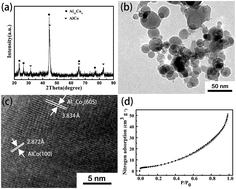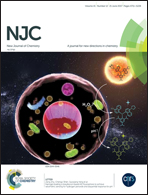Preparation and pseudocapacitive performance of microporous Co3O4–Co nanocomposites on Ni foam substrate†
Abstract
Microporous Co nanoparticles (NPs) with pore diameters of 0.38 nm have been prepared by dealloying Co–Al alloy NPs, which were subsequently annealed at different temperatures to synthesize microporous Co3O4–Co nanocomposites as electrode materials for pseudocapacitors. The NPs annealed at 423 K are made of Co3O4 and Co phases, and become pure Co3O4 after being annealed at 473 and 573 K. The pore diameter of the NPs does not change significantly upon increasing the annealing temperature from 423 to 573 K, whereas the specific surface area decreases from 39.25 to 26.68 m2 g−1 due to the sintering effect. The pseudocapacitive behavior of the microporous Co3O4–Co nanocomposites were investigated by cyclic voltammetry (CV) and chronopotentiometry (CP) tests. The microporous Co3O4–Co nanocomposite annealed at 423 K exhibits outstanding pseudocapacitive performance with a high specific capacitance (SC) of 507 F g−1 at 1 A g−1 and good cycling stability (93% retention of its initial specific capacitance after 1000 cycles). The SC value decreases to 77 F g−1 for the sample annealed at 573 K. The charge–discharge mechanism is discussed in terms of the microporous structure and the existence of the Co phase. The novel microporous material may open a new route to high performance pseudocapacitors.



 Please wait while we load your content...
Please wait while we load your content...